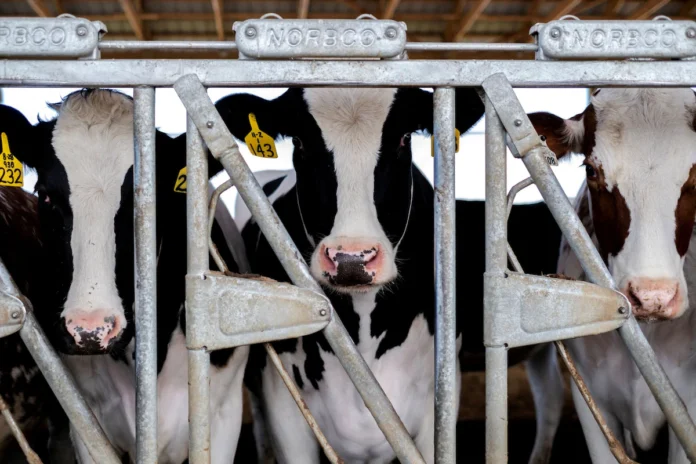The discovery of bird flu viral fragments in grocery store milk samples has raised concerns about the potential spread of the virus among dairy herds. While it is important to note that the presence of genetic material does not necessarily indicate a threat to human health, the fact that the virus is showing up in a larger number of samples suggests a wider spread of infection.The Food and Drug Administration (FDA) has been conducting rigorous testing throughout the dairy production process to monitor the presence of the virus. The standard process of pasteurization, which is used to treat milk, is effective in inactivating pathogens and making them unable to cause harm. However, it does not remove genetic material, which is why the viral fragments are still detectable in the milk samples.To determine whether the virus is still present and if it remains infectious, additional laboratory testing is currently underway. This testing will provide crucial information regarding the potential risk of illness associated with consuming the milk. The FDA is working diligently to ensure the safety of dairy products and will take appropriate measures based on the results of these tests.In the meantime, it is important for consumers to be aware of this development and to follow any guidance provided by the FDA or other relevant authorities. While the risk of contracting bird flu from consuming milk is currently uncertain, practicing good hygiene and proper food handling techniques can help reduce the overall risk of foodborne illnesses. This includes thoroughly washing hands before and after handling milk or any other food products, as well as properly storing and refrigerating perishable items.The detection of bird flu viral fragments in grocery store milk samples serves as a reminder of the importance of ongoing surveillance and monitoring of food production systems. By identifying and addressing potential risks, authorities can take proactive measures to protect public health and ensure the safety of the food supply. Continued research and collaboration between regulatory agencies, farmers, and the dairy industry will be crucial in managing and mitigating the spread of avian flu among dairy herds.
As part of ongoing efforts to ensure the safety of the milk supply, regulatory agencies and industry organizations have implemented rigorous testing protocols. These tests are designed to detect any potential pathogens or contaminants that may be present in milk samples. The FDA, in collaboration with state and local health departments, regularly conducts inspections of dairy farms and milk processing facilities to ensure compliance with safety standards.
In addition to these inspections, samples of milk are routinely collected and analyzed for the presence of bacteria, viruses, and other harmful substances. These tests are highly sensitive and can detect even trace amounts of contaminants. If any issues are identified, immediate action is taken to address the problem and prevent contaminated milk from reaching consumers.
Furthermore, the dairy industry has implemented a number of preventive measures to minimize the risk of contamination. This includes strict sanitation practices at dairy farms and processing facilities, as well as comprehensive training programs for employees to ensure proper handling and storage of milk. The industry also closely monitors the health of dairy cows, implementing strict protocols for the prevention and control of diseases.
While the safety of the milk supply is a top priority, it is important for consumers to also take precautions when handling and consuming milk. This includes proper refrigeration to maintain freshness, checking expiration dates, and avoiding consumption of milk that appears spoiled or has an unusual odor.
Overall, the combination of rigorous testing, industry practices, and consumer education efforts contribute to the safety of the milk supply. By working together, regulatory agencies, industry organizations, and consumers can ensure that milk and milk products continue to be a safe and nutritious part of our diet.
Preventing Contamination in the Milk Supply Chain
Ensuring the safety of the milk supply goes beyond testing and biosecurity measures. It is crucial to implement strict protocols throughout the entire milk supply chain to prevent contamination and maintain the integrity of the product.
Starting at the dairy farm, proper hygiene practices should be followed to minimize the risk of introducing pathogens into the milk. This includes regular cleaning and sanitization of milking equipment, proper handwashing by farm workers, and regular health checks for the dairy cows. Any cows showing signs of illness should be isolated and treated promptly to prevent the spread of disease.
During transportation, milk should be stored and transported at appropriate temperatures to prevent bacterial growth. Refrigerated trucks should be used to maintain the cold chain, ensuring that the milk remains at the recommended temperature throughout the journey from the farm to the processing facility.
At the processing facility, rigorous quality control measures should be in place to detect and eliminate any potential contaminants. This includes regular testing for pathogens, as well as monitoring the cleanliness and functionality of processing equipment. Any milk that does not meet the required safety standards should be rejected and not allowed to enter the market.
Proper packaging is also essential to prevent contamination. Milk should be packaged in sterile containers that are sealed to prevent any entry of bacteria or other contaminants. The packaging materials should be of high quality and comply with food safety regulations.
Furthermore, regular audits and inspections should be conducted at all stages of the milk supply chain to ensure compliance with safety standards and regulations. These audits can help identify any potential areas of improvement and address any issues before they become a threat to the safety of the milk supply.
By implementing these comprehensive measures, the risk of contamination in the milk supply chain can be minimized, ensuring the safety and quality of the milk consumed by the public. It is the collective responsibility of dairy farmers, processors, transporters, and regulators to work together to maintain the highest standards of safety and protect the health of consumers.

